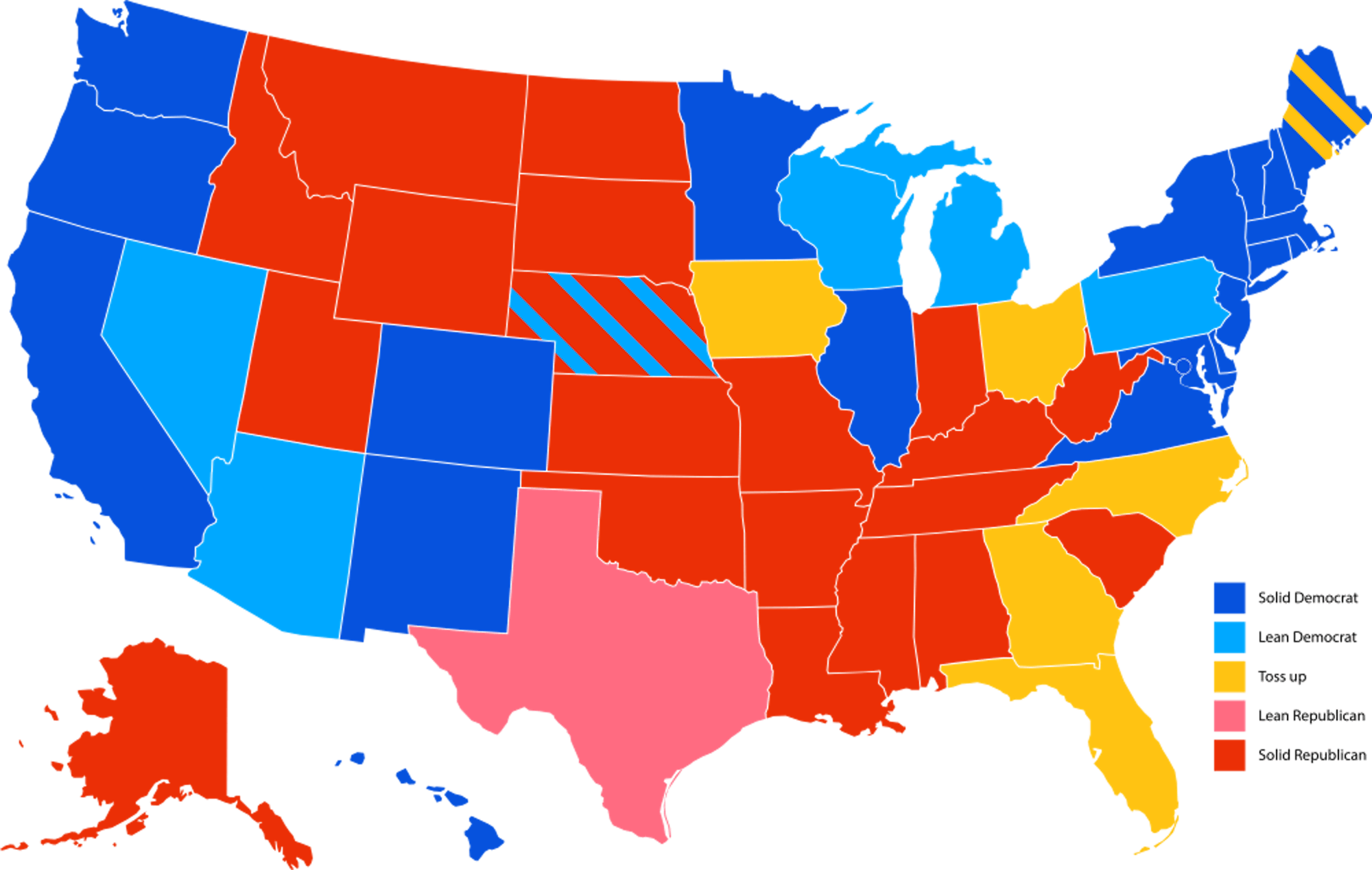Texas: With a growing Latinx population, the Lone Star State is becoming more of a toss-up. Demonstrated by former Rep. Beto O’Rourke’s competitive challenge to Sen. Ted Cruz in 2018, opposition and disapproval toward Trump and his allies have grown in the state, leading to a competitive election. Although it is predicted that President Donald Trump will win the state, if former Vice President Joe Biden were to emerge triumphant, it would be the first time Texas went blue since Carter’s election in 1976. This state will likely be one to watch in upcoming elections as the influence of Democrat-leaning voters with marginalized identities in the majority-minority state grows.
Ohio: Trump won Ohio by eight points in 2016, but the race is much closer this year. Early in the summer, Biden was leading in national election forecast models. However, in September the tides turned, and Trump has gained steam since then. As one of the more conservative Rust Belt states, Trump is expected to perform better here than in Michigan, Wisconsin and Pennsylvania. While it is still a toss-up, Trump could very likely eke out a win. A Biden victory is contingent on turnout among young voters while also siphoning off support from Trump among older voters.
Georgia: Long a Republican stronghold, Georgia is beginning to look like a swing state. Though Georgia is integral to a Trump victory, Biden is slightly favored to win the state, which has not gone blue for nearly three decades. While the rural areas typically go Republican, southwestern Georgia and the greater Atlanta area is supporting Biden in drives. Claims of voter suppression based on long wait times at early voting locations in predominantly Black neighborhoods that support Biden bring into question how the election will unfold in this swing state. If Georgia swings blue this election, it is likely indicative of a blue wave, with other toss-up states likely to fall in line.
Iowa: Trump slightly leads this Republican-leaning state heading into Election Day, according to forecast models. The state went from supporting Obama in both elections to backing Trump in 2016. Disapproval with Trump has built up in Iowa and has made it a true swing state. A Trump victory in the Hawkeye State relies on heavy turnout among his base of white men and those without college degrees. A Biden victory relies on high turnout among voters ages 35 and younger, as well as a shift away from Trump among older voters. The election will likely be decided Tuesday night, with a clear picture of the winner, but ballots can be received up to six days after the election as long as they are postmarked by Nov. 3.
Florida: The winner of Florida will most likely be decided on election night, as it allows mail-in ballots to be processed prior to Election Day. Florida has always been a close competition, including in 2016 when Trump won by just over 1%. This year, Florida is considered a true toss-up state, with Biden leading but only within the margin of error on aggregate election forecast models. Trump must win Florida for a chance at victory. If Biden wins the Sunshine State, Trump’s chances drop to almost zero.
North Carolina: Trump won the toss-up state in 2016 by nearly three points. The state was divided along urban-rural lines, with the counties near the North Carolina Research Triangle of the University of North Carolina Chapel Hill, Duke University and NC State University — a highly educated and affluent area — voting heavily for Hillary Clinton. The same trend is emerging this year based on polling. Biden holds just over a two-point lead in national election models. Despite accepting mail-in ballots until Nov. 12, the toss-up state will likely be decided on election night.
Arizona: Trump won Arizona in 2016, but it is now leaning toward Biden — though within the margin of error — in national election forecasts. After electing Democrat Kyrsten Sinema to the Senate in 2018, Democrats have eyed the state to gain ground in the Sun Belt. The state has gone for the Democratic presidential candidate only once since 1952, but similar to Texas, its increasing Latinx population is tilting the state blue. Current forecasts have Biden slightly favored to win by about 3%. However, claims of voter suppression against Latinx residents and Indigenous peoples, including a law prohibiting anyone from assisting a voter in filling out an absentee ballot, leave uncertainty in this election. Despite its election statutes allowing votes to be processed up to two weeks prior to Election Day, its results may not be known on election night.
Wisconsin: Just like Michigan, this state was neglected by the Clinton campaign and was won by Trump by less than 1%. Following Pennsylvania, Wisconsin is the most likely state to decide the next president. Biden holds a seven- to eight-point lead in the state according to election forecast models, but due to unfounded claims of voter fraud by Trump and the increased use of mail-in ballots, the election may not be decided until Wednesday at the earliest. A Biden victory is contingent on turnout in the Milwaukee area, as Wisconsin is one of more white and conservative Rust Belt states.
Pennsylvania: From Pennsylvania-native Biden beginning his candidacy for the 2020 election on the Ben Franklin Parkway to Trump’s constant references to fracking in the presidential debates, Pennsylvania has been the focus of this election. Many see this as the deciding state in the Electoral College. After winning the state by less than 1% in the 2016 presidential election, Trump’s support has dwindled, particularly in the more educated suburbs of Philadelphia. While election forecasts predict Biden winning Pennsylvania, it is unlikely that Pennsylvania will be decided on election night, as election statutes prohibit the counting of mail-in ballots prior to 7 a.m. on Election Day, and seven counties will not begin processing ballots until Wednesday. Due to its importance in this election, both candidates have spent much of the past two weeks campaigning across the state, trying to secure a lead that could determine the result of the 2020 election.
Michigan: Like the rest of the Rust Belt, this state received minimal attention from Clinton’s 2016 campaign and was won by Trump with less than a one-point margin of victory. This year, however, the state appears to have swung blue, according to election forecast models. Polls for the state have been consistent, predicting a seven- to eight-point lead for Biden. The state received an abundance of requests for absentee ballots and allows early voting. Nevertheless, Secretary of State Jocelyn Benson stated that this will slow the counting process and results may not be clear on election night. Preliminary numbers may favor Trump, as Democrats are more likely to be voting by mail.






